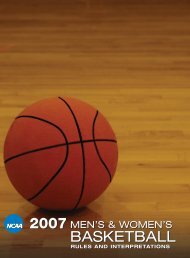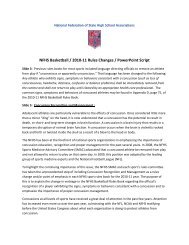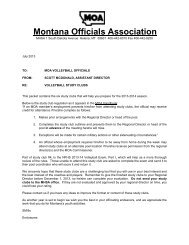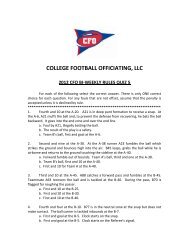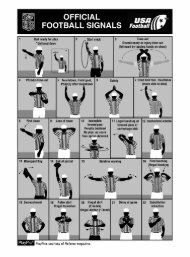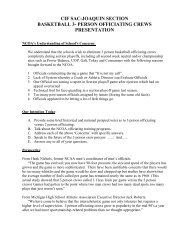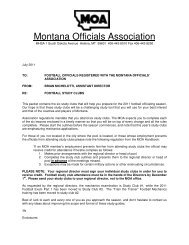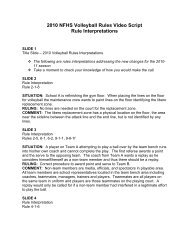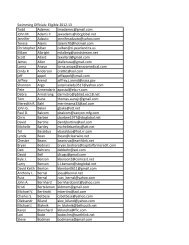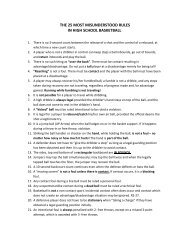2011-12 AND 2012-13 MEN'S AND WOMEN'S RULES - NAIA
2011-12 AND 2012-13 MEN'S AND WOMEN'S RULES - NAIA
2011-12 AND 2012-13 MEN'S AND WOMEN'S RULES - NAIA
You also want an ePaper? Increase the reach of your titles
YUMPU automatically turns print PDFs into web optimized ePapers that Google loves.
60<br />
RULE 4 / DEFINITIONS<br />
1. A ball that is not in contact with a player or the playing court retains<br />
the same status as when it was last in contact with a player or the<br />
playing court. This does not apply to a try in flight.<br />
b. A throw-in to the offended team (men) at the division line for a single<br />
contact dead ball technical or a single flagrant 2 technical and (women) a<br />
designated spot nearest to where the ball was located when the stoppage<br />
occurred for a contact dead ball technical foul, an administrative technical<br />
for an excessive timeout or a single flagrant 2 technical foul.<br />
c. A free throw or a throw-in when the stoppage occurred during this activity<br />
or when a team is entitled to such with no reset of the shot clock.<br />
d. An alternating-possession throw-in at a designated spot with a reset of<br />
the shot clock when the point of interruption is such that neither team<br />
is in control and no goal, infraction, nor end of half/extra period is<br />
involved. When there is no team control due to a try in flight and the try<br />
is unsuccessful, the ball is awarded to the team entitled to the atlernatingpossession<br />
arrow at a spot nearest to where the try was unsuccessful.<br />
(Exception: Rule 2-11.7.i.)<br />
Section 54. Post Player<br />
A post player is any offensive or defensive player in the lane area with or without<br />
the ball with his or her back to the basket. The lane area includes the three-second<br />
lane (Rule 4-69) and approximately three feet just outside the lane.<br />
Section 55. Rebound<br />
Art. 1. A rebound is an attempt by any player to secure possession of the ball<br />
after a try for goal. In a rebounding situation, there is no player or team control.<br />
Art. 2. To attain or maintain legal rebounding position, a player shall not:<br />
a. Displace, charge or push an opponent.<br />
b. Extend either or both shoulders, hips, knees or extend either or both arms<br />
or elbows fully or partially in a position other than vertical so that the<br />
freedom of movement of an opponent is hindered when contact with any<br />
of these body parts occurs.<br />
c. Bend his/her body in an abnormal position to hold or displace an<br />
opponent.<br />
d. Violate the principle of verticality.<br />
Art. 3. Every player shall be entitled to a spot on the playing court, provided that<br />
such player gets there first without illegally contacting an opponent. (Exception:<br />
Rule 4-35.7)<br />
Section 56. Restricted Area<br />
The restricted area is defined as the area bounded by the outer edge of the restricted<br />
area arc, which has a 3-foot radius measured from the center of the basket and<br />
extending to the face of the backboard (See court diagram in Rule 1). A secondary<br />
defender is considered to be in the restricted area when any part of either foot is in<br />
or above this area.





